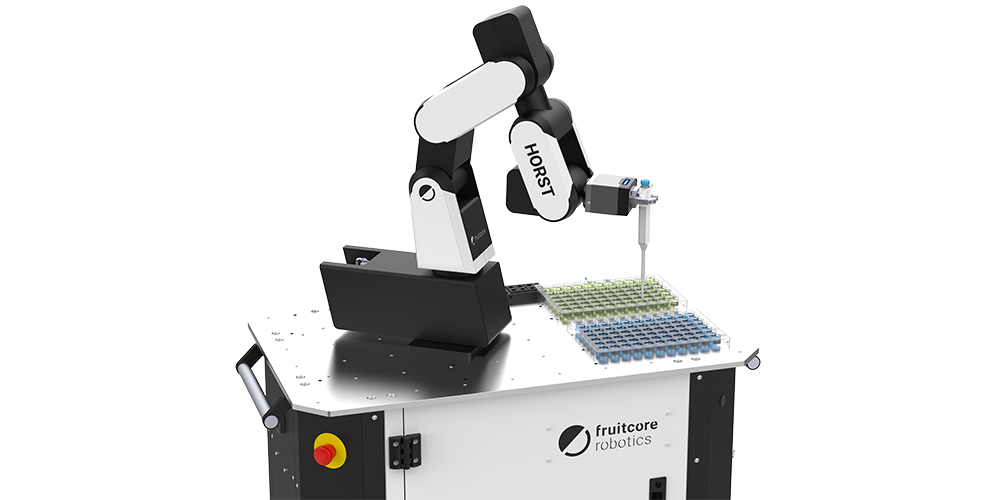4 Minuten zu lesen
5 Laborprozesse, die Sie jetzt automatisieren können – und warum
 Benjamin Brumm
:
Apr 7, 2025 7:30:00 AM
Benjamin Brumm
:
Apr 7, 2025 7:30:00 AM

Ob in der medizinischen Diagnostik, in Forschungs- oder in Qualitätssicherungslaboren: Die Nachfrage nach Probenbearbeitung sowie die Anforderungen an Präzision und Geschwindigkeit steigen kontinuierlich stark an. Wenn manuelle Routinearbeiten wie Pipettieren oder Sortieren viel Zeit kosten, führt das jedoch zu Belastung und Monotonie unter Labormitarbeitern. Es hemmt zusätzlich die mögliche Produktivität von Laboren. In diesem Artikel erklären wir deshalb, welche typischen Tätigkeiten Roboter in Laboren bereits heute automatisieren können – und welche konkreten Vorteile dadurch entstehen.
 1. Probenvorbereitung und Pipettieren
1. Probenvorbereitung und Pipettieren
Worum geht es?
Die Probenvorbereitung gehört zu den arbeits- und zeitintensivsten Tätigkeiten im Labor. Das manuelle Pipettieren ist nicht nur fehleranfällig, sondern für Mitarbeitende auch körperlich belastend. Zudem kostet es viel Konzentration, stets die richtige Pipettier-Menge zu treffen und Kontaminationen zu vermeiden.
Warum automatisieren?
- Höhere Präzision und Reproduzierbarkeit: Ein Roboter wiederholt jeden Schritt exakt gleich und vermeidet menschliche Fehler durch Ermüdung oder Unachtsamkeit.
- Entlastung des Personals: Anstatt stundenlang an der Pipette zu stehen, kann das Laborteam seine Expertise in wertschöpfendere Bereiche einbringen, etwa in die Interpretation von Analyseergebnissen. Durch Automatisierung von insbesondere einfacheren und repetitiven Aufgaben lassen sich zudem Personalkosten sparen.
- Zeit- und Kosteneinsparungen: Durch die Unterstützung von Robotern ist es möglich, Proben über längere Zeiträume autark ohne menschliche Eingriffe zu verarbeiten. Auch die Bearbeitungszeit verkürzt sich, ohne Einbußen bei der Qualität.
Praxisbeispiel
6-Achs-Industrieroboter, wozu zum Beispiel HORST Robotersysteme zählen, lassen sich mit sensiblen und labortauglichen Greifsystemen ausstatten, um Reagenzien hochpräzise zu dosieren. Mit einer entsprechend ausgerüsteten Software lässt sich das Pipettier-Setup dabei intuitiv grafisch festlegen und zügig und einfach an neue Methoden oder Protokolle anpassen.
 2. Probenlogistik und Sortierung
2. Probenlogistik und Sortierung
Worum geht es?
Gerade in der täglichen Routine klinischer Labore oder Dienstleistungslabore sammeln sich Probenröhrchen in großer Zahl an, müssen gescannt, verifiziert und auf verschiedene Analysegeräte verteilt werden. Auch die Archivierung – zum Beispiel in Kühlschränken oder Tiefkühlsystemen – bindet Kapazitäten.
Warum automatisieren?
- Abfedern von Lücken im Hochbetrieb: Meist erreichen Proben Labore in gewissen Stoßzeiten, z.B. mittags nach der morgendlichen Entnahme in Krankenhäusern oder Arztpraxen, und müssen dann schnell analysiert werden. Es herrschen somit Hochphasen von wenigen Stunden, für die sich schwer geeignete personelle Hilfe findet. Um dann nicht hochqualifizierte und -bezahlte Fachkräfte mit einfachen Aufgaben betrauen zu müssen, kann ein Roboter wesentlich kostengünstiger „einspringen“.
- Beschleunigte Durchlaufzeiten: Ein Roboterarm mit integrierter Kamera kann Probenröhrchen kontinuierlich sortieren, Barcodes scannen und die Proben passend aufteilen.
- Weniger Fehler und Verwechslungen: Die lückenlose Datenerfassung (etwa über Scanner) reduziert Fehlsortierungen drastisch.
- Nachtbetrieb möglich: Im Gegensatz zu rein manueller Sortierung, die eine Nachtschicht erfordern würde, kann ein Roboter-System in einer „Geisterschicht“ auch ohne Personal weiterarbeiten.
Praxisbeispiel
Mehrere Laborverbünde in Europa haben bereits Roboterlösungen zur Probenlogistik im Einsatz, die stündlich mehrere Hundert Röhrchen sortieren. Die Roboter können dabei auf einer mobilen Plattform stationiert werden, um sie am Ort der Beprobung zu positionieren und bei Bedarf schnell umzustellen – etwa von der Sortierung zur Maschinenbestückung.
 3. Beschickung von Analysegeräten
3. Beschickung von Analysegeräten
Worum geht es?
Geräte wie Zentrifugen, PCR-Systeme, Spektrometer oder chromatografische Analyseeinheiten laufen zwar teilautomatisiert, benötigen aber meist eine manuelle Zu- und Abführung. Dadurch bleiben teure Geräte zwischen den Bearbeitungsschritten teilweise ungenutzt.
Warum automatisieren?
- Optimale Auslastung der Geräte: Ein Roboter kann die Proben rund um die Uhr laden und entnehmen. So wird jede freie Minute genutzt.
- Gleichbleibende Prozessqualität: Die Bewegungen zum Greifen und Positionieren der Proben können vorab definiert werden, sodass diese zuverlässig und wiederholgenau be- und entladen werden. Das minimiert Schäden an empfindlichen Probengefäßen.
- Flexibles Setup: Moderne Automatisierungslösungen lassen sich auch in beengten Laborräumen installieren. Die besonders kompakte HORST600-Variante beispielsweise benötigt lediglich einen 230V-Anschluss und kann mit Schutzzaun oder laserüberwacht auch auf engstem Raum sicher betrieben werden.
Praxisbeispiel
In einem Diagnostikzentrum kann ein Roboter mit Doppelgreifer rund um die Uhr Proben aus Racks entnehmen, in ein Analysegerät einführen und anschließend das verarbeitete Röhrchen zur Archivierung in ein separates Tray ablegen. Das Laborpersonal kontrolliert nur noch die Resultate, statt repetitive Ladevorgänge auszuführen.
 4. Probenarchivierung und Lagerverwaltung
4. Probenarchivierung und Lagerverwaltung
Worum geht es?
Je nach Branche werden Proben und Rückstellmuster teils Monate oder Jahre lang gelagert. Das Sortieren in Lagerracks oder das Auffinden einzelner Proben zur späteren Nachanalyse bedeutet häufig einen immensen Verwaltungsaufwand.
Warum automatisieren?
- Schnelle, fehlerfreie Ein- und Auslagerung: Ein Roboter greift archivierte Proben hochpräzise. Über Datenverknüpfung (Barcode und Labor-IT) kann er die richtige Position ansteuern, ohne dass Personal in Kühlzellen oder in Gefrierschränken suchen muss.
- Reduktion körperlicher Belastung: Schwere Archivboxen entfallen für das Team. Gerade beim Arbeiten in Niedrigtemperatureinheiten verbessert das die Arbeitsbedingungen.
- Mehr Überblick durch digitale Vernetzung: Die Software protokolliert jede Ein- und Auslagerung automatisch. Für Audits oder Rückfragen ist sofort nachvollziehbar, wo sich welches Probenröhrchen befindet.
Praxisbeispiel
Häufig realisieren Labore eine Kombination aus Roboter-Anwendung und automatischem Lagersystem (z.B. Tiefkühl- oder Kühlschrankmodul). Hier helfen Roboter-Softwares, die bei der Schnittstellen-Kommunikation offen für viele Systeme sind, damit jede Bewegung dokumentiert werden kann. Innovative Software-Lösungen wie horstOS nutzen dabei auch die Vorzüge von Künstlicher Intelligenz und des Internet of Things. So lässt sich einstellen, dass die Software proaktiv darüber informiert, wenn z.B. bestimmte Proben an die Oberfläche geholt werden sollen.
 5. Dokumentation und Qualitätskontrolle
5. Dokumentation und Qualitätskontrolle
Worum geht es?
In vielen Laboren wird noch manuell dokumentiert – beispielsweise bei der Kontrolle von Füllständen, Pipettenkalibrierungen oder Protokollierung von Versuchsergebnissen. Das bindet Personal und ist fehleranfällig. Darum ist eine verlässliche Rückverfolgbarkeit, die sogenannte traceability, ein so wichtiges Thema für Laborbetriebe und betrifft im Grunde alle Bearbeitungsschritte.
Warum automatisieren?
- Lückenlose Datenerfassung: Gerade dann, wenn eine Probe mehrere Schritte innerhalb eines Labors durchläuft, ist die traceability ein wichtiges Thema. Bei unerwarteten Ergebnissen soll schließlich schnellstmöglich klar sein, wie diese zustande kamen. Ein vollständig automatisierter Prozess, bei dem jede Aktion des Roboters dokumentiert wird, erleichtert das im Vergleich zu aufeinanderfolgenden manuellen Arbeitsschritten enorm.
- Vermeidung menschlicher Fehler: Behördliche Vorgaben hinsichtlich der Nachverfolgbarkeit werden immer strenger, und mit ihnen steigen die Anforderungen an Präzision in Laboren. Menschliche Fehler (z.B. beim Beschriften oder durch Kontaminationen) lassen sich jedoch nie ganz ausschließen. Die Automatisierung dagegen gewährleistet eine einheitliche Dokumentation aller Prozesse und sorgt für verlässliche und leicht auffindbare Aufzeichnungen – ohne dass menschliche Eingriffe nötig sind.
- Echtzeit-Feedback: Werden Abweichungen wie z. B. zu niedrige Füllstände erkannt, kann das System einen Warnhinweis ausgeben und ggf. den Prozess unterbrechen
- Keine redundante Handarbeit: Die Mitarbeitenden konzentrieren sich auf die Interpretation der Daten, anstatt ihre wertvolle Zeit mit dem Ausfüllen von Formularen oder der manuellen Bestandsprüfung zu verbringen.
Praxisbeispiel
Ein Industrieroboter mit integrierter Kamera fährt Probenstationen ab, filmt/scannt Füllstände oder Farbveränderungen und überträgt die Messwerte automatisiert an die Labor-Software. Für die Absicherung kann eine zentrale Steuerung sorgen, die bei Unstimmigkeiten den Vorgang stoppt und gleichzeitig das Personal alarmiert – ganz ohne Zeitverlust.
Fazit: Schnell profitieren, flexibel wachsen
Diese fünf Beispiele zeigen, dass sich bereits mit der Automatisierung einzelner Laborprozesse deutliche Effizienz-, Qualitäts- und Zeitgewinne erzielen lassen. Wer sich für einen modularen Ansatz entscheidet – beispielsweise auf Basis des leicht zu bedienenden Industrieroboters HORST – kann sogar klein anfangen und Schritt für Schritt erweitern. So profitieren Sie sofort von kürzeren Durchlaufzeiten und geringerer Fehlerquote, ohne Zeit und Geld in Sonderanlagen investieren zu müssen.
Der Vorteil
- Entlastung Ihrer Teams von körperlich belastenden oder monotonen Handgriffen
- Rund-um-die-Uhr-Betrieb für zeitkritische Situationen oder in Hochphasen
- Zukunftssicherheit durch nachrüstbare Systemkomponenten und Software-Updates
- Schnelle Amortisation dank geringer Anschaffungs- und Wartungskosten
Wer jetzt in eine Robotik-Lösung investiert, macht sein Labor fit für die stetig steigenden Anforderungen an Tempo, Qualität und Wirtschaftlichkeit – und schafft ideale Bedingungen, um Fachkräfte zu entlasten und die Ergebnisqualität zu steigern.
Neugierig geworden?
Gerne beraten wir Sie persönlich, welcher Prozess in Ihrem Labor das größte Automatisierungspotenzial bietet. So starten Sie in kürzester Zeit, Ihre Proben, Geräte und Dokumentationen robotergestützt zu automatisieren – Schritt für Schritt, individuell an Ihre Anforderungen angepasst.
/Werbebilder%20Fruitcore-Mitarbeiter/fruitcore-robotics-free-trial-kontakt.webp?width=1065&height=1024&name=fruitcore-robotics-free-trial-kontakt.webp)
